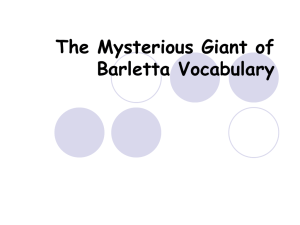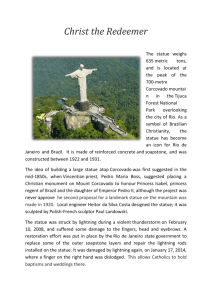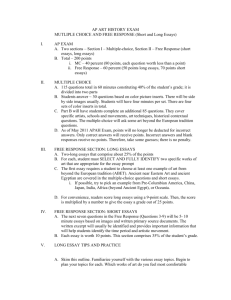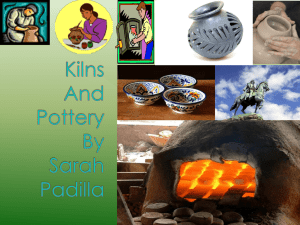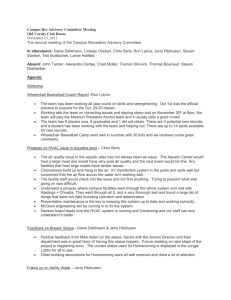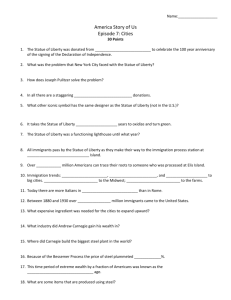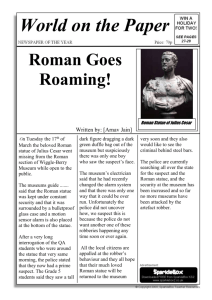AP ART HISTORY: LONG ESSAY
advertisement
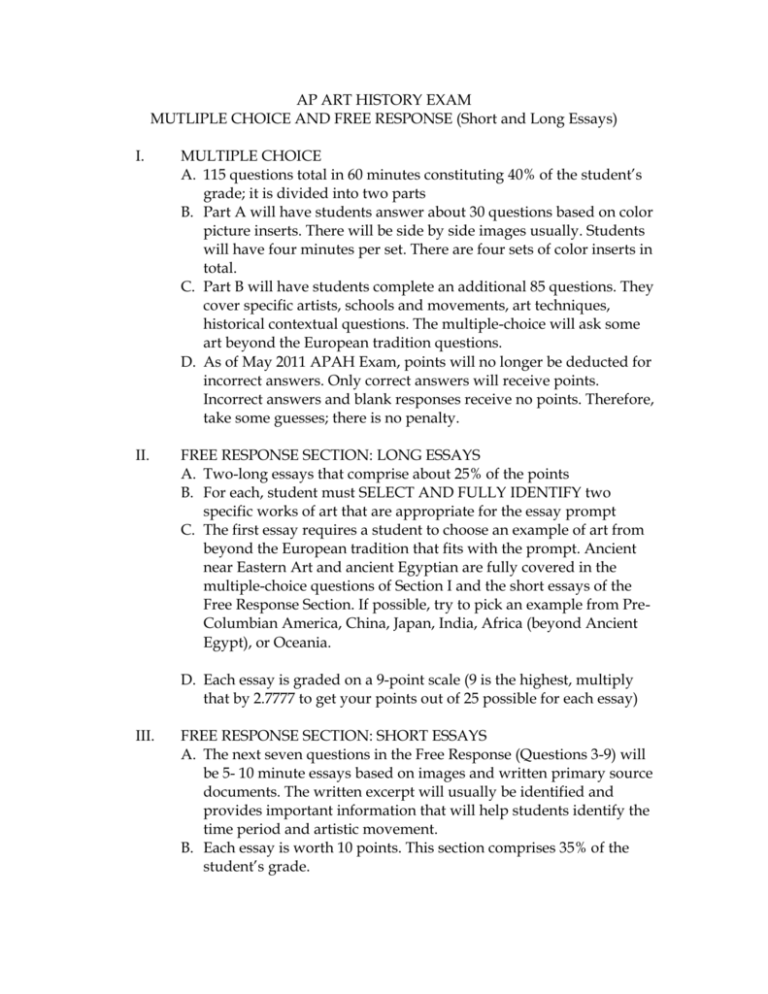
AP ART HISTORY EXAM MUTLIPLE CHOICE AND FREE RESPONSE (Short and Long Essays) I. MULTIPLE CHOICE A. 115 questions total in 60 minutes constituting 40% of the student’s grade; it is divided into two parts B. Part A will have students answer about 30 questions based on color picture inserts. There will be side by side images usually. Students will have four minutes per set. There are four sets of color inserts in total. C. Part B will have students complete an additional 85 questions. They cover specific artists, schools and movements, art techniques, historical contextual questions. The multiple-choice will ask some art beyond the European tradition questions. D. As of May 2011 APAH Exam, points will no longer be deducted for incorrect answers. Only correct answers will receive points. Incorrect answers and blank responses receive no points. Therefore, take some guesses; there is no penalty. II. FREE RESPONSE SECTION: LONG ESSAYS A. Two-long essays that comprise about 25% of the points B. For each, student must SELECT AND FULLY IDENTIFY two specific works of art that are appropriate for the essay prompt C. The first essay requires a student to choose an example of art from beyond the European tradition that fits with the prompt. Ancient near Eastern Art and ancient Egyptian are fully covered in the multiple-choice questions of Section I and the short essays of the Free Response Section. If possible, try to pick an example from PreColumbian America, China, Japan, India, Africa (beyond Ancient Egypt), or Oceania. D. Each essay is graded on a 9-point scale (9 is the highest, multiply that by 2.7777 to get your points out of 25 possible for each essay) III. FREE RESPONSE SECTION: SHORT ESSAYS A. The next seven questions in the Free Response (Questions 3-9) will be 5- 10 minute essays based on images and written primary source documents. The written excerpt will usually be identified and provides important information that will help students identify the time period and artistic movement. B. Each essay is worth 10 points. This section comprises 35% of the student’s grade. IV. LONG ESSAY TIPS AND PRACTICE A. Skim this outline. Familiarize yourself with the various essay topics. Begin to plan your topics for each. Which works of art do you feel most comfortable talking about? When you can write with knowledge and passion about works of art, your discussion is usually stronger. B. When you see the essay topic, don’t panic. Start making a list of several works of art that you think can fit the topic. Then, choose the work that you feel the most confident in describing. You should have 4 basic characteristics for each work of art that you choose. Explain your characteristics thoroughly, but stay on topic. C. NOTE: There are several examples of art that can be used for different topics Example: Seated Statue of Khafre (Human form in art, power and authority, object of religious ritual) D. Sample topics i. Human body in art ii. Objects related to religious ritual iii. Narrative in art iv. Sacred spaces (religious architecture and sites v. How art (including architecture) conveys power and authority vi. Patrons and their goals in commissioning specific works of art (including architecture) V. Sacred Objects in Art A. The prompt In many cultures, artists have produced images for religious use. Name two images, such as wall decorations, or other objects, each from a different culture. At least one image must be froma non-European or non-European-based culture. Discuss how the images conform to the beliefs of the culture in which they were produced, and in what ways each contributed to reinforcing those beliefs. (30 minutes) B. Mother and Child – Kongo Power Figure Produced by the Kongo culture Indigenous African cultures are polytheistic and also animists, meaning they worship spirits Strong belief in ancestors; you have an obligation to keep the ancestral spirits content by making offering to them and honoring them This figure may represent royalty (she wears a woven cap, chest scarification, and jewelry indicate her status) The figure may also be a divine mother figure – she is powerfully built and an enlarged head, has accentuated breasts, and cradles a baby Diviners are African spiritual specialists; they are able to connect with the spirit world through spells, rituals, and powders and herbs; diviners are very important to African tribes because of their ability to commune with and interpret the spirits. Diviners called this statue white chalk as a reference to its spiritual power (white chalk refers to one of the magical healing powders the diviners use); Diviners owned statues like this one to reinforce their power Some local women’s groups owned statues like this; the statue was believed to help African women with fertility issues. C. Nail figure (nkisi n’kondi) Kongo power figure Large standing male figure, powerful build, enlarged head Bristles with nails and blades Embodied a spirit believed to heal and give life Capable of inflicting harm as well Large nkisi n’kondi could protect a whole town from evil People insert nails and blades into the wooden statue to stir the spirit to action People go to the statue for blessings, healings, protection, and for the growth of crops Niche in belly usually contains an object that has medicinal properties that a diviner might use (this one has a cowry shell) D. Akua’ba Sculpted by Osei Bonsu Wooden statue of a young Akan girl Owned by the Akan people of Ghana Large flattened forehead is a sign of beauty among the Akan Mothers would gently mold their babies skulls to develop this feature This statue would be carried by a young woman hoping to conceive a child After becoming pregnant, the women would continue to carry the statue until she delivered a healthy and handsome boy or beautiful girl Africans worship spirits and different divinities – these spirits can inhabit objects and even people Akua’ba is believed to have the power to fulfill these desires and bless the pregnancy; akua’ba can also protect the pregnant women from any evil spirits or witchcraft that could harm her or the baby E. Senufo Mask from Cote d’Ivoire (Ivory Coast) Represents a composite creature Combines traits of antelope, crocodile, hyena, warthog, and human – fearsome and intelligent Horns one way, gaping mouth with large teeth Wearing the mask incarnates the spirits that can battle evil spirits, witchcraft, and the walking dead (zombies) Worn by a man during a funeral ceremony Powerful form functions as protectors of the soul and the village – mask acts as a weapon against evil Senufo maskers accompany the corpse of the deceased as it is brought from the village to burial Senufo maskers help the soul of the deceased make the final transition into the afterlife; also makes sure the deceased soul does not linger in the village The transition of the soul of the deceased into the proper dimension is important to African beliefs; Senufo masks ward off evil spirits that could interfere with the transition F. Shiva as Nataraja (Lord of the Dance) Shiva is a very important deity in Hinduism. He is the destroyer and creator of life; Hinduism is based on one universal spirit that can take on many different forms. When Hindus honor Shiva, he blesses them with strength Multiple arms indicates his divine status; Shiva is surrounded by a flaming nimbus, a ring of fire representing the cosmos Upper arms hold a drum because life is created based on the drum beat and the other holds a flame which represents destruction Lower arms use a gesture of welcome and protection under the upraised left foot of Shiva Shiva’s matted hair flies out to the sides as he dances to continue the cycle of destruction and creation. Shiva steps on a dwarf that represents ignorance This is not a statue of the god but the god himself Hindus wash and feed the god as well as carry the god out of the temple on holidays They fully clothe the statue and put garlands of flowers over him. Only his face expose, which they decorate with powder and make-up Prior to eating a meal, followers give the god part of a meal and wait for him to take up the essence of the food. Then, they eat it because it is considered blessed. G. Walking Buddha Buddhism stresses a life of self-denial, moderation, and meditation. Through these practices, a Buddhist can attain Enlightenment. Buddha was once known as Siddhartha Gautama, a wealthy young prince with a family, whose father sheltered him in the palace so that he would never know suffering. Siddhartha left the palace one day and witnessed suffering for the first time. He eschewed his princely life for the life of a wandering ascetic. He fasted so much that his ribs sunk in. Siddhartha reached an understanding through his asceticism; the best path to follow in life in the Middle Path, a path of moderation. When he reached this phase, he reached Enlightenment. Walking Buddha is from Sukhothai, Thailand. Theravadan Buddhism came to Sukhothai (See Chapter 6 for discussion of Buddhism) Part of a Buddhist monastery named Wat Mahathat. The monastery’s stupa (holy mound) contains a great relic of the Buddha. Wat Mahathat even means “Monastery of the Great Relic. Walking Buddha expresses Buddha’s beauty and perfection, he is a supernatural being. His right arm hangs loosely like an elephant’s trunk; elephants are revered in Thailand. His whole body has an elastic quality to represent Buddha’s life (from prince to starving ascetic to moderation and the Middle Path) VI. Left arm is raised in a fear-not gesture. Flame on top of Buddha’s head represents Enlightenment, which all Buddhists seek. This statue of Buddha is unique to Thailand; no other places that practice Buddhism have walking Buddha statues. This holy statue is important to the Sukhothai monastery, inspiring them in meditation on the monks’ path to Enlightenment. Sacred Spaces A. The essay prompt Virtually all of the world’s cultures have defined sacred spaces for religious purposes. The design and appearance of these spaces vary greatly. Full identify two specific sacred spaces, at least one of which must be from beyond the European tradition. For each choice, discuss the relationship between the appearance of the space and its religious function. (30 minutes0 VII. SAMPLE LONG ESSAY TOPICS AND EXAMPLES OF ART A. Below is a list of sample essay topics and appropriate choices. You can choose beyond the list. Check with us if you are concerned about the appropriateness and strength of your choice as well as solidifying your facts on the choices. These topics are merely suggestions. The accompanying notes are a model of how to describe a work of art in a way that answers the essay question. B. HUMAN FORM IN ART - Form and content in figurative (having human figures) art – w a culture is perceived is often expressed in depictions of the human figure. Choose two specific representations of the human body from different cultures. Only one of your choices may be from a European artistic tradition. Discuss significant aspects of each culture that are revealed by the way the human body is depicted. i. Seated Statue of Khafre (Non-European) 1. Old Kingdom Egyptian pharaoh 2. Funerary purpose – statue was kept in his funerary temple as an alternate dwelling place for his ka should his mummy decompose 3. Statue is meant to last for eternity to house the ka; the arms and legs are compact and close to the body and his throne so that no parts will break off; It is made out of diorite – the hardest stone known of that time period 4. Statue has an idealized body as would be appropriate for someone of the pharaoh’s status. Lesser government figures such as the Seated Scribe were more naturalistic. ii. Bust of Nefertiti (Non-European) 1. New Kingdom sculpture from Amarna period; she was the favorite wife of the iconoclast pharaoh, Akhenaten. During the Amarna period, the religion of Egyptian was changed towards monotheism and the artistic elements changed towards curvilinear appearances and a relaxation of previous Egyptian standards. 2. Her hair is pulled up in an elegant crown; deviated from the artistic norm for Egyptian queens in which they would wear the shoulder length Nubian wig. 3. Her long, graceful neck is exposed. Its curvilinear elements reflected the artistic elements of the Amarna period in which many human forms were curvilinear 4. Her almond eyes, high cheekbones, aquiline nose, and voluptuous lips all indicate a departure from the canonical depictions of Egyptian queens from earlier periods. These features reflect the physical beauty of Nefertiti, whose was written about in documents of the time as the “Beautiful One of the Palace.” iii. Shiva as Nataraja (Beyond European Tradition) 1. Representation of Hindu god as the destroyer of life and creator of life; Hinduism is based on one universal spirit that can take on many different forms. 2. Multiple arms indicates his divine status; Shiva is surrounded by a flaming nimbus, a ring of fire representing the cosmos 3. Upper arms hold a drum because life is created based on the drum beat and the other holds a flame which represents destruction 4. Lower arms use a gesture of welcome and protection under the upraised left foot of Shiva 5. Shiva’s matted hair flies out to the sides as he dances to continue the cycle of destruction and creation. 6. Shiva steps on a dwarf that represents ignorance iv. Venus of Willendorf (Beyond the European Tradition) 1. Prehistoric representation of fertility; precedes the establishment of Western civilization by the Ancient Greeks and is thus beyond the European Tradition even though it was found in Europe. 2. Represented the importance of fertility and motherhood to prehistoric peoples. Several statues of this type were found in the region and given the name Venus by archaeologists based on their feminine attributes 3. Wide hips indicate the ability to bear children; Pubic triangle is emphasized to show the importance of childbirth. Occasionally, traces of red ocher paint were found in the pubic area possible indicating the blood of childbirth. 4. Large breasts indicate motherhood and nursing. 5. Parts not directly related to fertility or motherhood lack naturalism. Stylized curly hair or possibly a woven hat on the head. Facial features are nothing more than a few holes. Arms are twig-like, lack interest in underlying structure, and rest on the breasts. Legs taper downwards toward undeveloped feet. v. European-based examples 1. Doryphoros by Polykleitos 2. Market Woman (Hellenistic) 3. Boxer (Hellenistic) 4. Venus de Milo (Hellenistic) 5. Augustus Primaporta 6. David by Michelangelo 7. Louis XIV by Rigaud 8. The Grand Odalisque by Ingres 9. Le Demoiselles d’ Avignon by Picasso 10. Woman with a Hat by Matisse 11. Marilyn Monroe silkscreen by Andy Warhol ALTERNATE VERSION OF HUMAN BODY ESSAY: The human body has often been highly abstracted or stylized in the history of art. Choose two works from different cultures (one from beyond the European tradition) in which the body has been stylized or highly abstracted. Examples: Beyond European tradition Venus of Willendorf (prehistoric) Pillar statue of Akhenaten Hatshepsut-Sphinx statue OR Great Sphinx of Khafre at Giza European tradition Le Demoiselles d’Avignon by Picasso Woman with the Hat or Woman with Green Stripe by Matisse Mademoiselle Pogany by Brancusi The Kiss by Brancusi Characters on the Bayeaux Tapestry Street Dresden by Kirchner (German Expressionism – Die Brucke) Mary in Egypt by Nolde (German Expressionism) C. Narrative in Art – Select and fully identify two works that convey a narrative (tell a story). One example must be from beyond the European tradition. Identify the subject of each narrative and discuss the means used to convey each narrative. i. Beyond European Tradtion 1. Palette of Narmer 2. Standard of Ur 3. Weighing the Heart Ceremony, Detail from Egyptian Book of the Dead 4. Tale of Genji (Japan) ii. European Tradition 1. Bronze doors of Saint Michael’s Hildesheim (Ottonian) 2. Ceiling of the Sistine Chapel 3. Bayeaux Tapestry (Norman, 11th Century) 4. Third of May, 1808 by Goya 5. Guernica by Picasso 6. Death of Marat by Jacques-Louis David 7. Death of General Wolfe by Benjamin West D. Sacred Spaces – Many cultures designate spaces or create structures for religious devotion. Choose two specific examples, each from a different culture. At least one must be non-European or nonEuropean based. Identify your examples and their cultures. Discuss the ways in which your examples create places appropriate for religious devotion in each culture. Consider (if applicable) plan, orientation, site, structure, ornamentation, etc. i. Beyond European Tradition 1. The Great pyramid of Khufu at Giza 2. The Temple of Horus at Korfu (pylon temple) 3. The Temple of Amun at Karnak (pylon temple) 4. The Great Stupa at Sanchi 5. The Great Mosque in Tunisia 6. The Great Mosque in Mecca (with the Kaaba) a. Discuss the Kaaba, the importance of Mecca, the parts of a mosque in general, etc. ii. European Tradition 1. Saint Sernin (Romanesque) 2. La Madelein at Vezelay (Romanesque – launching point for several Crusades) 3. Chartres (Gothic) 4. Saint Peter’s (Renaissance) 5. Parthenon (Classical Greece) 6. Pantheon (Rome) 7. Temple of Vesta at Tivoli (Rome) 8. Hagia Sophia (Byzantine) 9. San Vitale, Ravenna (Byzantine) E. Select two portrait paintings (NOT SELF-PORAITS), each of a single individual by different artists, and from different periods. Identify each work by title and artist. How does each work reflect the stylistic tendencies of the artist’s own time? Compare and contrast how each artist portrays the person’s individuality. 1. Gertrude Stein, Picasso 2. Henry VIII, Hans Holbein 3. Philip IV (several of them including the equestrian portrait), Velazquez 4. Collossal Statue of Constantine 5. Prima Porta Augusta 6. Portrait of don Manuel Osorio de Zuniga, Goya 7. Duchess of Alba, Goya 8. Balzac, Rodin 9. Gattamelata, Donatello 10. Equestrian statue of Marcus Aurelius 11. Mona Lisa, Leonardo Da Vinci 12. Louis XIV, Rigaud 13. Bust of Louis XIV, Bernini 14. Death of Marat, David 15. Napoleon Crossing the Alps, David 16. Princess de Broglie, Ingres 17. Statue of Voltaire, Houdon 18. Statue of George Washington, Houdon 19. Seated Statue of Khafre F. ART AND ITS ORIGINAL SETTING: In order to understand a work of art fully, one must understand their original or intended settings. For example, most works of art in museums today have removed from their original settings… Fully identify two works of art and their original settings. Each example must come from different original settings. Discuss how knowledge of the original settings contributes to a more complete understanding of each work. i. Isenheim Altarpiece by Grunewald from the chapel of the Hospital of Saint Anthony, Isenheim, Germany ii. Panathenaic Friezes from the Parthenon (British Museum, part of Elgin Marbles) iii. Augustus Primaporta statue (Vatican Museum, Rome) iv. Nike of Samothrace aka Winged Victory (Louvre); set up in the Sanctuary of the Great Gods on the island of Samothrace; part of fountain, placed on the upper basin of a two-tiered fountain v. New York Kouros (Metropolitan Museum of Art) vi. Death mask of Tutankhamen from innermost coffin (Egyptian Museum in Cairo) vii. Last Judgment of Hu-Nefer, from his tomb in Thebes (page from Book of the Dead) (British Museum) viii. Saturn Devouring One of His Children (Goya’s Black Paintings) (Museo del Prado, Madrid) ix. Virgin and Child, principal panel of the Maesta altarpiece (Museo dell’Opera del Duomo, Siena) x. Merode Altarpiece, Robert Campin aka Master of the Flemalle (intended for private devotion) (Metropolitan Museum of Art – Cloisters Collection) xi. Ishtar Gate (Staatliche Museen in Berlin) G. Power and Authority 1. The prompt Choose two specific images of power and authority, each produced in a different culture. At least one must come from a non-European-based tradition. How does each work of art convey that particular culture’s notion of what constitutes power and authority. H. ARCHITECTURE AND POWER AND AUTHORITY: Many cultures have used architecture to convey power and authority. Choose two works of architecture from different cultures, identifying each as fully as possible. One must be from beyond the European tradition. Discuss how each work conveys power and authority. i. Great Pyramid of Khufu at Giza ii. Temple of Ramses II at Abu Simbel iii. Great Temple of Tenochtitlan (Aztecs) iv. Parthenon v. Colosseum vi. Versailles vii. Saint Peter’s in Rome viii. Campidoglio in Rome I. Choose and fully identify two works of art after 500 C.E. that combine images with text. Note: Do not choose works that consist only of names, labels, or artistic signatures. Discuss the relationship between the text and the images of the two works you have chosen. i. This Is Not a Pipe by Renee Magritte ii. Hopeless by Roy Lichtenstein iii. Bayeaux Tapestry iv. The True Artist Helps the World by Revealing Mystic Truths by Bruce Nauman (Concept Art 1960’s) v. Still Life with Chair Caning by Picasso vi. Two Children Are Threatened by a Nightengale by Max Ernst vii. Battle of Issus (1529) by Albrecht Altdorfer (inscription at the top) J. Many artists radically transform actual observation and experience to express their unique artistic vision. Select two works each by a different artist. Discuss ways in which each artist transformed observed reality in order to capture a personal vision. i. Mont Sainte Victoire by Cezanne ii. iii. iv. v. vi. vii. viii. ix. x. xi. xii. Woman with a Hat (Portrait of Madame Matisse) by Matisse Portrait of Gertrude Stein by Picasso Le Demoiselles d’Avignon by Picasso Portrait of Ambroise Vollard by Picasso The Vision after the Sermon by Gaugin Starry Night by Vincent Van Gogh The Scream by Munch The Sleeping Gypsy by Rousseau Impression Sunrise by Monet Walking Man by Rodin Bird in Space by Brancusi or the Kiss by Brancusi K. In many cultures, artists have produced images for religious use. Name two images such as wall decorations, sculptures, or other items, each from a different culture. One must be from beyond the European tradition. Discuss how the images conform to the cultures in which they were produced and how they reinforce the beliefs of those religions. i. Statuette of Worshipper from the Square Temple at Eshnunna (Sumerian votive figure) ii. Lamassu iii. Shiva as Nataraja Statue iv. Last Judgment of Hu-Nefer, Book of the Dead v. Isenheim Altarpiece vi. Bronze Doors of Saint Michael’s at Hildesheim, Germany vii. Virgin and Child between Saints Theodore and George, Byzantine icon L. The representation of light in painting has been used to serve a variety of purposes. Identify two artists, each from a different art historical periods, who have explored the effects of light. Discuss the function and use of light in specific works by each artist. i. Leonardo da Vinci ii. Caravaggio iii. Claude Monet iv. Henri Toulouse-Latrec v. El Greco vi. Albert Bierstadt (Hudson River School) vii. Rembrandt van Rijn viii. Georges da La Tour (candle-lit religious scenes)
